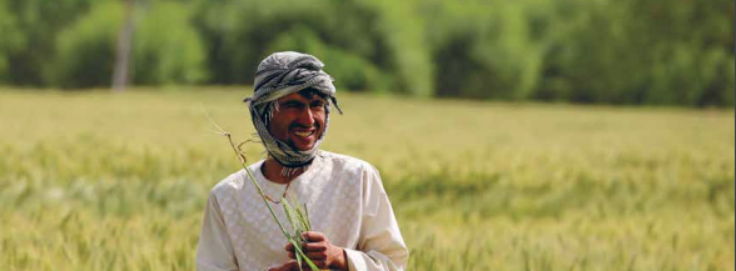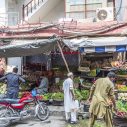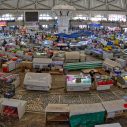
Search
New Afghan Multidimensional Poverty Report

Today, 31 March, the Islamic Republic of Afghanistan launched its first Afghanistan Multidimensional Poverty Index (A-MPI), shows that just over half (51.7 percent ) of people in Afghanistan are multidimensionally poor. The level of multidimensional poverty ranges from a low of 12% in Kabul to a high of 81% in Baghdis.
“The Afghanistan Multidimensional Poverty Index complements the monetary poverty measure and uncovers the deprivations experienced by the Afghan people in various aspects of their life,” says, Ahmad Jawed Rasuli, Director General of the National Statistics & Information Agency (NSIA). “It will also be instrumental for developing effective poverty reduction policies informed budget allocation, policy coordination and integrated policies.”
The A-MPI provides an in-depth portrait of poverty. Singling out children, it finds that 58% of all multidimensionally poor people in Afghanistan are children under 18 years of age. Poverty rates are highest among the Kuchi population, 89% of which are MPI poor. In all, rural areas are home to 83% of multidimensionally poor people.
 The A-MPI has 18 indicators grouped in 5 dimensions: Health, Education, Living Standards, Work and Shocks. The A-MPI complements monetary poverty measure, providing an overview of poverty nationally. Going a step further, it also acts as a high-resolution lens to look into the different dimensions of poverty, disaggregated by region, age or household type.
The A-MPI has 18 indicators grouped in 5 dimensions: Health, Education, Living Standards, Work and Shocks. The A-MPI complements monetary poverty measure, providing an overview of poverty nationally. Going a step further, it also acts as a high-resolution lens to look into the different dimensions of poverty, disaggregated by region, age or household type.
“The A-MPI will be reported in the SDGs, and will enable us to address poverty in all its forms and dimensions, and to do so using integrated high-power policies – which is our national aim, and is also the first and fundamental priority of the SDGs, says the Minister of Economy.
Because the MPI starts by finding out how each household fares in each of these indicators – from assisted maternal delivery to child school attendance, from employment and youth not in employment, education or training (NEET) to security shocks, from cooking fuel to land and livestock – it offers an easy-to-understand yet powerful tool for policy coordination, budgeting and integrated policy design.
“UNICEF views with grave concern the staggering levels of poverty, with children, almost 60%, being the highest”, says Jean Gough, UNICEF Regional Director for South Asia. “This finding is a clarion call to action. We need to urgently quadruple our efforts and investments across all sectors so that we can protect and secure Afghanistan’s future – as the greatest investment and the prosperity of this nation lies in its children,” Gough emphasised.
‘NSIA has produced a rigorous and technically precise measure of multidimensional poverty, aligned to national priorities. We hope the A-MPI is used to coordinate high-impact policies, and to monitor – and celebrate – an historic reduction of the heavy burden of poverty’, highlighted Dr. Sabina Alkire, Director of the Oxford Poverty and Human Development Initiative (OPHI) at Oxford University.
KEY FINDINGS FROM THE REPORT
Rural Areas are home to 83% of poor people
 Multidimensional poverty in Afghanistan’s urban areas affects 18% of people but in rural areas – which house 70% of the country’s population – the figure is 61%. Multidimensional poverty affects a shocking 89% of Kuchi people. Thus, whereas Kuchi are only 5% of the population, roughly 9% of Afghanistan’s poor people are Kuchi – the same number as live in urban areas. But multidimensiona poverty clearly requires a rural strategy: 83% of poor Afghans live in rural areas.
Multidimensional poverty in Afghanistan’s urban areas affects 18% of people but in rural areas – which house 70% of the country’s population – the figure is 61%. Multidimensional poverty affects a shocking 89% of Kuchi people. Thus, whereas Kuchi are only 5% of the population, roughly 9% of Afghanistan’s poor people are Kuchi – the same number as live in urban areas. But multidimensiona poverty clearly requires a rural strategy: 83% of poor Afghans live in rural areas.
Provincial poverty rates vary from 12% to 81%.
Among provinces, Badghis, Nooristan, Kunduz, Zabul and Samangan are among the poorest regions, and Kabul, Panjsher, Kapisa, Logar and Pakitlka are the least poor.
Herat houses the largest number of multidimensional poor people followed by Nangarhar, Kandahar, Kunduz and Faryab. Kabul is the least poor, but still, 4.5% of all poor people -nearly one out of 20 – live in Kabul.
In terms of policy priorities, the composition of A-MPI by indicato varies considerably across provinces, so each provincial strategy can draw upon its own detailed analysis to inform its own strategic action plan.
The A-MPI complements Afghanistans Monetary Poverty Measure
 The A-MPI supports a balanced poverty reduction strategy by bringing into view deprivations that monetary poverty measures do not. It is true that nationally the numbers are similar: the NSIA’s analysis of the Afghanistan Living Conditions Survey (ALCS) 2016-17 survey showed that 51.7 percent of the population is MPI poor and 54.5 percent of the population are consumption poor. The fascinating fact is these are not all the same people. Only 36.3 percent of Afghans are both income poor and MPI poor. Otherwise, the MPI brings into view other people.
The A-MPI supports a balanced poverty reduction strategy by bringing into view deprivations that monetary poverty measures do not. It is true that nationally the numbers are similar: the NSIA’s analysis of the Afghanistan Living Conditions Survey (ALCS) 2016-17 survey showed that 51.7 percent of the population is MPI poor and 54.5 percent of the population are consumption poor. The fascinating fact is these are not all the same people. Only 36.3 percent of Afghans are both income poor and MPI poor. Otherwise, the MPI brings into view other people.
Provides evidence to guide policy
The MPI shows how people are poor. How? It can be unpacked to show the indicator composition of poverty for any group – be it children, Kuchis, or female-headed households.
At the national level, for example, of the 18 indicators, the highest deprivation is in female schooling, where nearly half of the population – 48% – live in a household where no female 10 years or older has completed primary schooling or even knows how to read and write. The next highest deprivations are in cooking fuel, where 41% of people are at risk of indoor air pollution that causes respiratory infections, and 39% of Afghans are MPI poor and share their household with a school aged child who is not attending school, while 35% live in a house in which a woman failed to receive proper pre-natal care or an assisted delivery. 25% of Afghans are MPI poor and strongly affected by some kind of security shock from which they have not recovered. 32% of people live in MPI poor households where less than one in six persons is employed, and for 23%, no one in the labour force is employed.
Afghanistan joins many countries who fight and end poverty in all its forms using MPI
The MPI is a better policy tool because it tracks the breadth of poverty among the poorest, as well as reductions in the poverty rate. This has been the experience of many countries across the world – from Colombia to Nepal, from Armenia to Mozambique – that use national MPIs alongside monetary poverty metrics as official permanent statistics and tools to fight poverty in all its forms and dimensions.
The report, which was financially supported by the UNICEF country office in Afghanistan, is the first release of the Islamic Republic of Afghanistan’s official and permanent statistic of Multidimensional Poverty. The National Statistics and Information Agency and Oxford University’s leading centre on multidimensional poverty, Oxford Poverty & Human Development Initiative (OPHI), worked collaboratively on the report.
Afghanistan Multidimensional Poverty Index 2016–2017 Report and Analysis is available here.
















